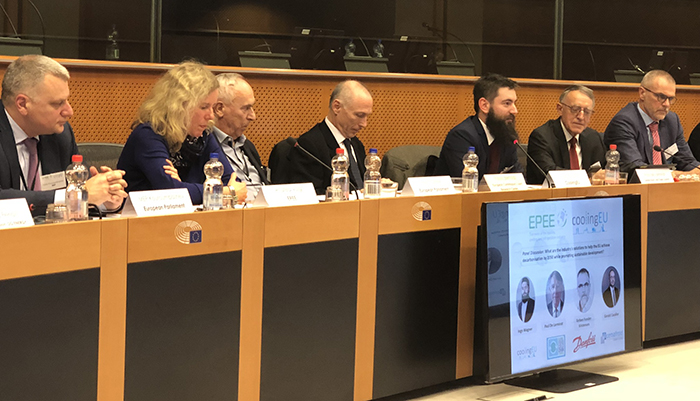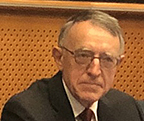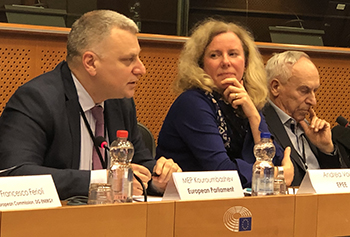Europe Setting Path for Climate Neutrality
From ASHRAE HVAC&R Industry News February 14, 2019
By W. S. Comstock, Contributing Editor, Europe & Middle East
BRUSSELS—With the recent completion of the European Union’s Clean Energy Package (including the revised Energy Efficiency Directive, Renewable Energy Directive and Energy Performance in Buildings Directive), the EU continues to implement measures aimed at driving the necessary investments to provide security of supply, while decarbonizing the European energy system and supporting energy production from renewable energy. In order to complement this recently finalized Clean Energy Package, the European Commission is now focusing its efforts on ensuring the world does not exceed a temperature increase of 1.5°C and identifying key focus areas to fight climate change with a new Strategy for a Climate Neutral Economy by 2050.
A 2018 UN climate science panel report concluded the world has already warmed by 1°C since pre-industrial times due to human activity. If the current pace of warming continues, the report stated, it is likely to pass the 1.5°C mark between 2030 and 2052. There will be worse heatwaves, drought and flooding at 2°C compared to 1.5°C and sea levels would rise 10cm higher this century.
The scope of the problem along with technology and public policy solutions were presented at a briefing organized by EPEE (European Partnership for Energy and the Environment) and coolingEU (a cross sectoral platform uniting associations from the cooling and refrigeration sectors).

Panelists describe EU’s pathway to decarbonization. |
Paolo Bertoldi with the European Commission’s Joint Research Center said the EU has made climate change one of its top priorities. Adaptation strategies are needed at all levels of administration—local, regional, national, European, and international level. Due to the varying severity and nature of climate impacts between regions in Europe, most adaptation initiatives will be taken at the regional or local levels, he said.
To avoid excessive climate change, he sees change needed in all phases of human activity. “Strengthened multi-level government, institutional capacity, policy instruments, technological innovation, mobilization of finance, changes in human behavior and lifestyles are enabling conditions that enhance feasibility for 1.5°C consistent system transitions,” he said. Bertoldi called for EU Member States to adopt comprehensive adaptation strategies and provide funding. “We need to promote adaptation in vulnerable sectors such as agriculture, fisheries and offer a coherent policy, guaranteeing that Europe's infrastructure is made more resilient. We must promote better informed decision-making by addressing gaps in knowledge about climate change adaptation and further developing the European climate adaptation platform.”

de Larminat |
Technology solutions are available. But the answer lies in more than finding ways to improve equipment efficiency, said Paul de Larminat representing the Global Food Cold Chain Council. “Machines are near to the maximum extent of their efficiency. The laws of physics limit what is possible,” he said. De Larminat called for reducing thermal load, looking at system efficiencies, and using common sense approaches to further reduce energy consumption. “We need building envelopes, closed door display cabinets, for example. And unlike electricity, thermal energy is easily stored. We need to shave peaks of mismatch between supply and demand of electricity through use of renewables.” De Larminat envisions thermal energy distribution grids and integration within smart interconnected systems.
Torben Funder-Kristensen of Danfoss presented another example for savings. “Compressors use 17% of all electricity,” he said, “Yet the majority of all systems only utilize 50% of the compressors’ work.” He also sees systems solutions with the creation of thermal networks that expand the perception of smart systems and the scope for compression systems. “District heating and cooling networks are perfect for thermal energy storage even if limited in temperature range. Vapor compression systems can store energy. They can upgrade temperature levels to grid demand and in some application areas, thermal storage can provide flexibility in electricity consumption.” He suggested combining photovoltaic and refrigeration and heating into a local “micro-grid power system.”
 |
| Member European Parliament (MEP) Peter Kouroumbashev, Andrea Voigt, and MEP Adam Gierek. |
While feasible to meet the 1.5°C limit, said the experts, government must present a European vision that will move new technology into the market. Francesco Ferioli with the European Commission’s Directorate General for Energy said all sectors have to contribute. For buildings he foresees an increased use of heat pumps and especially an increased renovation rate in the residential sector from around its current level of 1.7% to 1.8%. The revised Energy Performance of Buildings Directive which came into force in July 2018 is one step to increase investment in buildings. But that’s not enough to achieve the EU’s 2050 goals, Ferioli said. “There will be a need for additional investment of 150 to 290 billion EUR per year. The EU needs to move from 2% of EU GDP invested in the energy system today to 2.8% to achieve a net zero greenhouse gas emissions economy.” He added the effort should lead to positive economic growth and job creation with higher GDP by up to 2% in 2050. “Modernizing and decarbonizing the EU’s economy will stimulate significant additional investment.”
Carbon neutrality is feasible, according to the policy makers. A key will be participation by citizens, said Andrea Voigt, Secretary General of EPEE. “There needs to be incentives for the citizen,” she said. “They need to see the benefits, not just the challenges.”